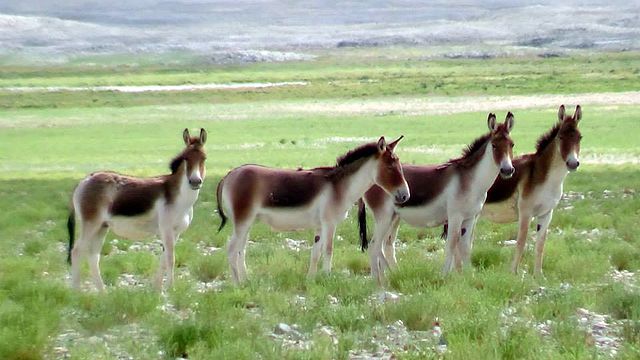The hilly region of Ladakh is rich with various species of flora and fauna, some of which are endemic to the area. The pastures and skies of Ladakh are filled with wild animals and birds that experience a calm and fulfilling life here without much disturbance and change. This uniquely placed region has a climate and topography perfect for a wide range of animals and birds. The black-necked crane and snow leopard rule the wildlife kingdom of Ladakh along with several other species living together peacefully. Several hotels in Ladakh are situated near some or other place where wildlife or birdlife can be seen.

Though wildlife and human life do not mix much in the higher reaches, they often fall into conflict when the wild migrate down due to food scarcity. Different types of wool and fur are also procured by hunting some of these species by the locals though, in the past, excessive hunting has lead to the extinction of some of these species.

Wildlife or fauna of Ladakh
Ladakhi forests, valleys and snow-clad peaks have a rich diversity of mammals. Snow leopard, red panda, Asian black bear, barking deer and blackbuck are some of the numerous animals spotted in these forests. Ladakh is also home to the Ladakh sandgrouse, white-throated langur, Himalayan tahr, spotted deer and Himalayan golden cat. Deer are abundant in the lower reaches.
Wild animals in Ladakh include wild boar, chinkara, deer, bear, kiang, langur, leopard, porcupine, tiger and fox.
During winters, when the snow melts, there are chances of a dip in the water table, so animals prefer living in villages and are more accessible to humans. However, Ladakhis still prefer to keep their animals in forested areas.
Most of the large mammals in Ladakh are indigenous to the region. The snow leopard, which is a rare and vulnerable species, is mostly found in the higher reaches of eastern Ladakh and has been a subject of concern. The highly endangered black-necked crane and red fox are also found in Ladakh. The recent report of a wild snow leopard has increased the concern about the fate of the species, but the actual status is unknown due to a lack of serious study.
Ladakh was the last refuge of the black bear but despite the huge mammals that once roamed the Ladakh region, very few have survived into the 21st century. Now, the only remnant of the species is one family of bears in the Chomulsang Wildlife Sanctuary, a part of the Kunzum La area, near Leh.
Sphynx, a six-meter long anaconda can be seen in Central Ladakh. Giant Malayan pit viper (it can grow up to eight feet in length) and Gharial, crocodile with poisonous venom can be seen in the Indus valley. It was once the main predator of Bengal tigers but today is rarely seen in its natural habitat and can be found in the Tso, Pal and Drowther valleys of East Tibet. Leopard, snow leopard and binturong – Leopard, snow leopard and binturong are the primary predators in Ladakh.
Snow leopard – Ladakh’s native wildlife is the world’s largest cat, so much so that it has been categorised as Endangered. They are reclusive and nocturnal in nature. It can live for up to 15-17 years and can reach up to a weight of 100kg.

One of the critically endangered species of birds is called the black-necked crane – The black-necked crane species is the largest bird of its genus, reaching up to a maximum height of about 3 metres (9 feet) tall. While this beautiful bird has no natural predators, hunting for meat and feathers pose a serious threat to its survival.
Cold weather and the absence of suitable food and nesting sites coupled with noise pollution have led to their massive population decline in Ladakh and across Ladakh. Despite the decline and endangerment, many non-profits work to protect these species.
By means of responsible tourism, travellers can sightsee and experience the nature of Ladakh at its peak. Wildlife photography is also quite amazingly executed in this unique region with even more uncommon species of wildlife. When you book a hotels in Ladakh, make sure to visit a lake nearby since that is where most of the bird and wildlife gathers for some refreshments.

